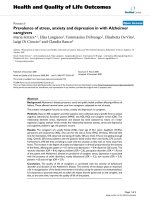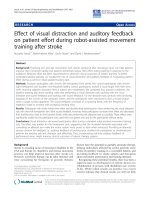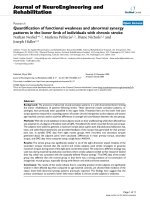Báo cáo hóa học: " Characterizations of the solution sets of pseudoinvex programs and variational inequalities" pot
Bạn đang xem bản rút gọn của tài liệu. Xem và tải ngay bản đầy đủ của tài liệu tại đây (297.11 KB, 13 trang )
RESEARCH Open Access
Characterizations of the solution sets of
pseudoinvex programs and variational
inequalities
Caiping Liu
1
, Xinmin Yang
2*
and Heungwing Lee
3
* Correspondence: xmyang@cqnu.
edu.cn
2
Department of Mathematics,
Chongqing Normal University,
Chongqing 400047, China
Full list of author information is
available at the end of the article
Abstract
A new concept of nondifferentiable pseudoinvex functions is introduced. Based on
the basic properties of this class of pseudoinvex functions, several new and simple
characterizations of the solution sets for nondifferentiable pseudoinvex programs are
given. Our results are extension and improvement of some results obtained by
Mangasarian (Oper. Res. Lett., 7, 21-26, 1988), Jeyakumar and Yang (J. Optim. Theory
Appl., 87, 747-755, 1995), Ansari et al. (Riv. Mat. Sci. Econ. Soc., 22, 31-39, 1999), Yang
(J. Optim. Theory Appl., 140, 537-542, 2009). The concepts of Stampacchi a-type
variational-like inequalities and Minty-type variational-like inequalities, defined by
upper Dini directional derivative, are introduced. The relationships between the
variational-like inequalities and the nondifferentiable pseudoinvex optimization
problems are established. And, the characterizations of the solution sets for the
Stampacchia-type variational-like inequalities and Minty-type variational-like
inequalities are derived.
Keywords: Solution sets, Pseudoinvex programs, Variational-like inequalities, Optimi-
zation problem, Dini directional derivatives
1 Introduction
Characterizations and properties of the solution sets are useful for u nderstanding the
behavior of solution methods for pro grams that have multiple optimal solutions. Man-
gasarian [1] presented several characterizations of the solution sets for differentiable
convex programs and applied them to study monotone linear complementarity pro-
blems. Since then, various extensions of these solutions set characterizations to nondif-
ferentiable convex programs, infinite-dimensional convex programs, and multi-
objective convex programs have been given in [2-4]. Moreover, Jeyakumar and Yang
[5] extended the results in [1] to differentiable pseudolinear programs; Ansari et al. [6]
extended the results in [5] to differentiable h-pseudolinear programs; Yang [7]
extended the results in [1,5,6] to differentiable pseudoinvex programs. In this paper,
we extend the results in [1,5-7] to the nondifferentiable pseudoinvex programs and
give the characterizations of solution sets for nondifferentiable pseudoinvex programs.
The variational inequalities are closely related to optimization problems. Under cer-
tain conditions, a variational inequality and an optimization problem are equivalent. As
Mancino and Stampacchia [8] pointed out: if Γ is an open and convex subset of R
n
Liu et al. Journal of Inequalities and Applications 2011, 2011:32
/>© 2011 Liu et al; licensee Springer. This is a n Open Access article distributed under the terms of the C reat ive Commons Attribution
License (http://creativecommons. org/licenses/by/2.0), which permits unrestricted use, distribution, and reproduction in any medium,
provided the original work is properly cited.
and F : Γ ® R
n
is the gradient of the differentiable convex function f : Γ ® R, then the
variational inequality (VI): find
¯
x
∈
, such that
(
y −
¯
x
)
T
F
(
¯
x
)
≥ 0, ∀y ∈
,
is equivalent to the optimization problem {min f(x), x Î Γ}. An important generaliza-
tion of variational inequalities is variational-like inequalities (VLI): find
¯
x
∈
, such that
η
(
y,
¯
x
)
T
F
(
¯
x
)
≥ 0, ∀y ∈
,
where h : Γ × Γ ® R
n
. Parida et al. [9] studied the existence of the solution of (VLI)
and established the relationships between the variational-like inequalities (VLI) and dif-
ferentiable convex programs. But the object ive function of an optimization problem is
not always differentiable; therefore, the variational inequalities defined by the direc-
tional derivative are introduced. For example, Crespi et al. [10,11] introduced the
Minty variational in equalities defined by lower Dini derivative and established the rela-
tionships between Minty variational inequalities and optimization problems. Later, Iva-
nov [12] established the relationships between variational inequalities and
nondifferentiable pseudoconvex optimization problems and applied them to obtain the
characterizations of solution sets of Stampacchia variational inequalities and Minty var-
iational inequalities. In this paper, we introduce Stampacchia-type variational-like
inequalities and Minty-type variational-like inequalities defined by upper Dini direc-
tional derivative, and based on the relationships between variational-like inequalities
and optimizati on problems, we gi ve the characterizations of solu tion sets of these two
classes of variational-like inequalities.
2 Preliminaries
In this paper, let R
n
be a real n-dimensional Euclidean space, Γ a nonempty subset of
R
n
, f : Γ ® R a real-valued function, and h : Γ × Γ ® R
n
avector-valued function.
Firstly, we recall some notions that will be used throughout the paper.
Definition 2.1. (See [13]) AsetΓ is said to be h-invex if, for any x, y Î Γ and an y l
Î [0, 1],
y + λη
(
x, y
)
∈
.
Definition 2.2.(See[13])Afunctionf: Γ ® R is said to b e preinvex with respect to
h on the h-invex set Γ if, for any x, y Î Γ and any l Î [0, 1],
f
(
y + λη
(
x, y
))
≤ λf
(
x
)
+
(
1 − λ
)
f
(
y
).
Definition 2.3. (See [14]) Afunctionf: Γ ® R is said to be prequasiinvex with
respect to h on the h-invex set Γ if, for any x, y Î Γ and any l Î [0, 1],
f
(
y + λη
(
x, y
))
≤ max{f
(
x
)
, f
(
y
)
}
.
Definition 2.4. (See [15]) A function f : Γ ® R is said to be semistrictly prequasiinvex
with respect to h on the h-invex set Γ if, for any x, y Î Γ with f (x) ≠ f (y) and any l Î
[0, 1],
f
(
y + λη
(
x, y
))
< max{f
(
x
)
, f
(
y
)
}
.
Liu et al. Journal of Inequalities and Applications 2011, 2011:32
/>Page 2 of 13
Condition A (See [16]):
f
(
y + η
(
x, y
))
≤ f
(
x
)
, ∀x, y ∈
.
Condition C (See [14]): Let Γ be an h-invex set. For any x, y Î Γ and any l Î [0, 1],
η(y, y + λη(x, y)) = −λη(x, y),
η
(
x, y + λη
(
x, y
))
=
(
1 −λ
)
η
(
x, y
).
Obviously, the map h(x, y)=x-ysatisfies Conditions A and C.
Remark 2.1. (See [16]) If Condition C is satisfied, then
η(y + λ
1
η(x , y), y + λ
2
η(x , y)) = (λ
1
− λ
2
)η( x , y), ∀λ
1
, λ
2
∈ (0, 1)
;
η
(
y + λη
(
x, y
)
, y
)
= λη
(
x, y
)
, ∀λ ∈ [0, 1].
Definition 2.5. The upper Dini directio nal derivative of f at x Î Γ in the direction d
Î R
n
is defined by
f
+
(x; d) = lim sup
t
→
0
+
f (x + td) −f (x)
t
,
which is an element of R ∪ {± ∞}.
Definition 2.6. (See [17]) A function h : R
n
® R is said to be:
(1) positively homogeneous if ∀x Î R
n
, ∀r>0, one has h(rx)=rh(x);
(2) subodd if ∀x Î R
n
\{0}, one has h(x)+h(-x) ≥ 0.
It is clear that the upper Dini directional derivative is positively homogeneous with
respect to the direction d Î R
n
.
Definition 2.7. The function f : Γ ® R is called radially upper semicontinuous on the
h-invex set Γ, if the function g(l):=f (y + lh (x, y)) is upper semicontinuous on [0,1],
for any x, y Î Γ.
Next, we give a mean value theorem.
Theorem 2.1. (Mean Value Theorem) Let f : Γ ® R be radially upper semicontinu-
ous on the h-invex set Γ, and let f satisfy Condition A. Then, for any x, y Î Γ, there
exists a point u Î {y + lh (x, y):l Î [0, 1)}, such that
f (x) − f (y) ≥ f
+
(u; η(x, y))
.
Proof. Let g : [0, 1] ® R be a function defined by
g
(
λ
)
:=
f (
y + λη
(
x, y
)).
Then, for any l Î [0, 1),
g
+
(λ; 1) = lim sup
t→0
+
g(λ + t) −g(λ)
t
= lim sup
t→0
+
f (y +(λ + t)η(x, y)) −f (y + λη(x, y))
t
= f
+
(y + λη(x, y); η(x, y)).
(2:1)
Let p : [0, 1] ® R be another function defined by
p
(
λ
)
:= g
(
λ
)
+ λ
(
f
(
y
)
− f
(
y + η
(
x, y
))).
(2:2)
Liu et al. Journal of Inequalities and Applications 2011, 2011:32
/>Page 3 of 13
It follows from radially upper semico ntinuity of f that p is upper semicontinuous on
[0,1]. Note that p(0) = p(1) = f(y). Therefore, p attains maximum at some point
¯
λ ∈ [0, 1
)
, which implies
p
+
(
¯
λ; 1) = lim sup
t
→
0
+
p(
¯
λ + t) −p(
¯
λ)
t
≤ 0
.
(2:3)
From (2.2) and (2.1), we have
p
+
(
¯
λ;1) =g
+
(
¯
λ;1)+f (y) −f(y + η(x, y)) = f
+
(y +
¯
λη(x, y); η(x, y)) + f(y) −f (y +η( x , y))
.
(2:4)
From (2.3) and (2.4), we have
f (y + η(x, y)) − f (y) ≥ f
+
(y +
¯
λη(x, y); η(x, y))
.
Set
u
= y +
¯
λη
(
x, y
)
, then u Î {y + lh (x, y):l Î [0, 1)}. By Condition A, we obtain
f (x) − f (y) ≥ f
+
(u; η(x, y))
.
■
Remark 2.2. In Theorem 2.1, u Î {y + lh (x, y):l Î [0, 1)} means that there exists
¯
λ ∈ [0, 1
)
, such that
u
= y +
¯
λη
(
x, y
)
.
3 Pseudoinvexity
In this section, w e introduce the concept of pseudoinvexity defined by upper Dini
directional derivative and give some properties for this class of pseudoinvexity.
Definition 3.1.(See[18])The function f : Γ ® Rissaidtobepseudoconvexoncon-
vex set Γ if
x, y ∈ , f
+
(y; x −y) ≥ 0 ⇒ f (x) ≥ f(y)
.
The following concept of pseudoinvexity is a natural extension for pseudoconvexity.
Definition 3.2. The function f : Γ ® R is said to be pseudoinvex with respect to h on
the h-invex set Γ if
x, y ∈ , f
+
(y; η(x, y)) ≥ 0 ⇒ f (x) ≥ f (y)
.
By Definitions 3.1 and 3.2, it is clear that every pseud oconvex function is pseudoin-
vex function with respect to h(x, y)=x-y, but the converse is not true.
Examples 3.1 and 3.2 will show that a pseudoinvex function with respect to a given
mapping h : Γ × Γ ® R
n
is not necessarily pseudoconvex function.
Example 3.1. Let
= {(x
1
, x
2
) ∈ R
2
: x
2
∈ (−
π
2
,
π
2
)
}
, and let f : Γ ® R, h : Γ × Γ ®
R
2
be functions defined by
f (x
1
, x
2
)=x
1
+sinx
2
,
η(x , y)=
x
1
− y
1
,
sin x
2
− sin y
2
cos y
2
,
where x =(x
1
, x
2
) Î Γ , y =(y
1
, y
2
) Î Γ . Then, f is pseudoinvex with respect to the
given mapping h. But it is not pseudoconvex, because there exist
x =
1+
√
2
4
π, −
π
4
,
y =(1,
π
4
)
, such that
f
+
(y; x − y)=
0
, but
f (x)=
√
2
4
π +1−
√
2
2
< 1+
√
2
2
= f (y
)
.
Liu et al. Journal of Inequalities and Applications 2011, 2011:32
/>Page 4 of 13
Example 3.2. Let f : R ® R, h : R × R ® R be defined by
f
(
x
)
= −|x |, x ∈ R
;
η(x , y)=
x −y, x ≥ 0, y ≥ 0orx ≤ 0, y ≤ 0,
y, x > 0, y < 0orx < 0, y > 0
.
Then, f is pseudoinvex with respect to the given mappi ng h. But it is not pseudocon-
vex, because there exist x =-5,y =4,such that
f
+
(y; x − y)=9>
0
, but f (x)=-5<-4
= f (y).
Definition 3.3. (See [19]) The bifunction h : Γ × R
n
® R is said to be pseudomono-
tone on if, for any x, y Î Γ,
h
(
x; y − x
)
≥ 0 ⇒ h
(
y; x − y
)
≤ 0
.
We extend this pseudomonotonicity to h-pseudomonotonicity.
Definition 3.4. Let Γ × Γ ® R
n
be a given mapping. The bifunction h : Γ × R
n
® R ∪
{± ∞} is said to be h-pseudomonotone on Γ if, for any x, y Î Γ,
h
(
x; η
(
y, x
))
≥ 0 ⇒ h
(
y; η
(
x, y
))
≤ 0
.
The above implication is equivalent to the following implication:
h
(
y; η
(
x, y
))
> 0 ⇒ h
(
x; η
(
y, x
))
< 0
.
Next, we present some properties for pseudoinvexity.
Theorem 3.1. Let f : Γ ® R be radially upper semicontinuous on the h-invex set Γ.
Suppose that
(1) f is a pseudoinvex function with respect to h on Γ;
(2) f and h satisfy Conditions A and C, respectively;
(3)
f
+
is subodd in the second argument.
Then, f is a prequasiinvex function with respect to the same h on Γ.
Proof. Suppose, on the contrary, f is not prequasiinvex with respect to h on Γ. Then,
∃ x, y Î Γ,
∃
¯
λ ∈
(
0, 1
]
, such that
f
(
y +
¯
λη
(
x, y
))
> max{f
(
x
)
, f
(
y
)
}
.
Without loss of generality, let f (y) ≥ f (x), then
f
(
y +
¯
λη
(
x, y
))
> f
(
y
)
≥ f
(
x
).
(3:1)
From radially upper semicontinuity of f, (3.1) and Condition A, there exists l* Î (0,
1) such that
f (y + λ
∗
η(x , y)) = max
λ∈
[
0,1
]
{f (y + λη(x, y))}
,
i.e.,
f
(
y + λη
(
x, y
))
≤ f
(
y + λ
∗
η
(
x, y
))
, ∀λ ∈ [0, 1]
.
(3:2)
Liu et al. Journal of Inequalities and Applications 2011, 2011:32
/>Page 5 of 13
Hence,
f
+
(y + λ
∗
η(x , y); η(x, y)) = lim sup
t
→
0
+
f (y +(λ
∗
+ t)η(x, y)) −f (y + λ
∗
η(x , y))
t
≤ 0
.
(3:3)
Since h satisfies Condition C and
f
+
is subodd in the second argument, then (3.3)
implies
f
+
(y + λ
∗
η(x , y); η(y, y + λ
∗
η(x , y))) ≥ 0
.
According to the pseudoinvexity of f, we have
f
(
y
)
≥ f
(
y + λ
∗
η
(
x, y
)).
(3:4)
From (3.1) and (3.2), we get
f
(
y
)
< f
(
y + λ
∗
η
(
x, y
)),
which contradicts (3.4). Hence, f is a prequasiinvex function with respect to h on Γ.
■
Theorem 3.2. Let Γ be an h-invex subset of R
n
,andleth : Γ × Γ ® R
n
be a given
mapping. Suppose that
(1) f : Γ ® R is radially upper semicontinuous on Γ ;
(2) f and h satisfy Conditions A and C, respectively;
(3)
f
+
is subodd in the second argument.
Then, f is pseudoinvex with respect to h on Γ if and only if
f
+
is h-pseudomonotone on
Γ.
Proof. Suppose that f is pseudoinvex with respect to h on Γ. Let x, y Î Γ,
f
+
(x, η(y, x)) ≥ 0
.
(3:5)
In order to show
f
+
is h-pseudomonotone on Γ,weneedtoshow
f
+
(y, η(x, y)) ≤
0
.
Assume, on the contrary,
f
+
(y; η(x, y)) > 0
.
(3:6)
According to the pseudoinvexity of f,from(3.5),wegetf (y) ≥ f (x), from (3.6), we
get f (x) ≥ f (y). Hence, f (x)=f (y). By Theorem 3.1, we know that f is also preq uasiin-
vex with respect to the same h on Γ, which implies
f
(
y + λη
(
x, y
))
≤ f
(
x
)
= f
(
y
)
, ∀λ ∈ [0, 1]
.
Consequently,
f
+
(y; η(x, y)) = lim sup
t
→
0
+
f (y + tη(x, y)) −f (y)
t
≤ 0
,
which contradicts (3.6).
Conversely, suppose that
f
+
is h-pseudomonotone on Γ. Let x, y Î Γ,
f
+
(y; η(x, y)) ≥ 0
.
(3:7)
In order to show that f is a pseudoinvex function with respect to h on Γ, we need to
show f (x) ≥ f (y). Assume, on the contrary,
Liu et al. Journal of Inequalities and Applications 2011, 2011:32
/>Page 6 of 13
f
(
x
)
< f
(
y
).
(3:8)
According to the mean value Theorem 2.1,
∃
¯
λ ∈ [0, 1
)
,
u
= y +
¯
λη
(
x, y
)
such that
f (x) − f (y) ≥ f
+
(u; η(x, y))
.
(3:9)
From (3.8) and (3.9), we get
f
+
(u; η(x, y)) < 0
.
(3:10)
Note that
u = y +
¯
λη
(
x, y
)
,if
¯
λ =
0
, from (3.10 ), we get
f
+
(y; η(x, y)) <
0
, which con-
tradicts (3.7). Hence,
¯
λ ∈
(
0, 1
)
.Since
f
+
is subodd in the second argument, (3.10)
implies
f
+
(u; −η(x, y)) > 0
.
(3:11)
It follows from (3.11) and
¯
λ ∈
(
0, 1
)
that
f
+
(u; −
¯
λη(x, y)) >
0
. By Condition C, we
get
f
+
(u; η(y, u)) > 0
.
From the h-pseudomonotonicity of
f
+
,weget
f
+
(y; η(u, y)) <
0
. Again using the
Condition C, we obtain
f
+
(y; η(x, y)) <
0
, which contradicts (3.7). ■
Theorem 3.3. Let f : Γ ® R be radially upper semicontinuous on the h-invex set Γ.
Suppose that
(1) f is a pseudoinvex function with respect to h on Γ;
(2) f and h satisfy Conditions A and C, respectively;
(3)
f
+
is subodd in the second argument.
Then, f is semistrictly prequasiinvex with respect to the same h on Γ.
Proof.Suppose,onthecontrary,f is not a semistrictly prequasiinvex function with
respect to h on Γ, then there exist points x, y Î Γ with f (x) ≠ f (y) and
¯
λ ∈
(
0, 1
)
such
that
f
(
y +
¯
λη
(
x, y
))
≥ max{f
(
x
)
, f
(
y
)
}
.
Without loss of generality, let f (y) >f(x), then
f
(
y +
¯
λη
(
x, y
))
≥ f
(
y
)
> f
(
x
).
(3:12)
By the mean value Theorem 2.1, ∃l* Î (0, 1),
u
= y +
¯
λη
(
x, y
)
+ λ
∗
η
(
y, y +
¯
λη
(
x, y
))
such that
0 ≥ f(y) − f(y +
¯
λη(x, y)) ≥ f
+
(u; η(y, y +
¯
λη(x, y)))
.
(3:13)
According to Conditi on C and (3.13), we get
f
+
(u; −
¯
λη(x, y)) ≤
0
. By the suboddity
and positively homogeneity of
f
+
in the second argument, we have
f
+
(u; η(x, y)) ≥ 0
.
(3:14)
Note that
u
= y +
¯
λ
(
1 −λ
∗
)
η
(
x, y
)
,ifl* = 0, then
u
= y +
¯
λη
(
x, y
)
. From (3.13), we get
0 ≥ f
+
(y +
¯
λη(x, y); η(y, y +
¯
λη(x, y)))
.
Liu et al. Journal of Inequalities and Applications 2011, 2011:32
/>Page 7 of 13
Since
f
+
is subodd and positively homogeneous in the second argument, from Condi-
tion C, we have
f
+
(y +
¯
λη(x, y); η(x, y)) ≥ 0
.
Consequently,
f
+
(y +
¯
λη(x, y); η(x, y +
¯
λη(x, y)) ≥
0
. By the pseudoinvexity of f,
f
(
x
)
≥ f
(
y +
¯
λη
(
x, y
)
, which contradicts (3.12). Therefore , l* ≠ 0andl* Î (0, 1). F rom
(3.14),
u
= y +
¯
λ
(
1 −λ
∗
)
η
(
x, y
)
, Remark 2.1 and l* Î (0, 1), we get
f
+
(y +
¯
λ(1 −λ
∗
)η( x , y); η(y +
¯
λη(x, y), y +
¯
λ(1 −λ
∗
)η( x , y))) ≥ 0
.
By Theorem 3.2, we know
f
+
is h-pseudomonotone on Γ. Therefore,
f
+
(y +
¯
λη(x, y); η(y +
¯
λ(1 −λ
∗
)η( x , y), y +
¯
λη(x, y))) ≤ 0
.
From Condition C, the suboddity and positively homogeneity of
f
+
in the second
argument, we obtain
f
+
(y +
¯
λη(x, y); η(x, y)) ≥ 0
.
Hence,
f
+
(y +
¯
λη(x, y); η(x, y +
¯
λη(x, y))) ≥
0
.Fromthepseudoinvexityoff,weget
f
(
x
)
≥ f
(
y +
¯
λη
(
x, y
)
, which contradicts (3.12). ■
4 Characterizations of the solution sets of pseudoinvex programs
Consider the nonlinear optimization problem
(P )
min f (x)
s.t. x ∈
,
where Γ is an h-invex subset of R
n
and f : Γ ® R is a real-valued nondifferentiable
pseudoinvex function on Γ . This class of optimization problems is called the class of
pseudoinvex programs.
We assume that the solution set of (P), denoted by
S := argmin{f
(
x
)
|x ∈ }
,
is nonempty. Next, we state our main results.
Theorem 4.1. Let f : Γ ® R be radially upper semicontinuous on the h-invex set Γ.
Suppose that
(1) f is a pseudoinvex function with respect to h on Γ;
(2) f and h satisfy Conditions A and C, respectively;
(3)
f
+
is subodd in the second argument.
Then, the solution set S of (P) is an h-invex set.
Proof. Let x, y Î S, then for any z Î Γ,
f
(
x
)
= f
(
y
)
≤ f
(
z
).
According to Theorem 3.1, we know that f is a prequasiinvex function with respect
to h on Γ, which implies
f
(
y + λη
(
x, y
))
≤ max{f
(
x
)
, f
(
y
)
}≤f
(
z
)
, ∀λ ∈ [0, 1], ∀z ∈
.
Liu et al. Journal of Inequalities and Applications 2011, 2011:32
/>Page 8 of 13
Hence, y + lh(x, y) S, for any l Î [0, 1]. ■
Lemma 4.1. Let f : Γ ® R be radially upper semicontinuous on the h-invex set Γ.
Suppose that
(1) f is a pseudoinvex function with respect to h on Γ;
(2) f and h satisfy Conditions A and C, respectively;
(3)
f
+
is subodd in the second argument.
Then, ∀ x, y Î S,
f
+
(x, η(y, x)) = f
+
(y, η(x, y)) = 0
.
Proof. Since x, y Î S, we obtain
f
+
(x, η(y, x)) ≥ 0
,
(4:1)
f
+
(y, η(x, y)) ≥ 0
.
(4:2)
Based on the pseudoinvexity of f and Theorem 3.2, we kn ow
f
+
is h-pseudomono-
tone. Hence, inequalities (4.1) and (4.2) imply, respectively,
f
+
(y, η(x, y)) ≤ 0
,
(4:3)
f
+
(x, η(y, x)) ≤ 0
.
(4:4)
Thus, (4.1) and (4.4) imply
f
+
(x, η(y, x)) =
0
, (4.2) and (4.3) imply
f
+
(y, η(x, y)) =
0
■
Theorem 4.2. Let f : Γ ® R be radially upper semicontinuous on the h-invex set Γ,
and let
¯
x
∈ S
be a given point. Suppose that
(1) f is a pseudoinvex function with respect to h on Γ;
(2) f and h satisfy Conditions A and C, respectively;
(3)
f
+
is subodd in the second argument.
Then,
S =
˜
S =
˜
S
1
= S
∗
= S
∗
1
=
˜
S ∩
ˆ
S
,
where
˜
S :={x ∈ |f
+
(x; η(
¯
x, x)) = 0},
˜
S
1
:={x ∈ |f
+
(x; η(
¯
x, x)) ≥ 0},
S
∗
:={x ∈ |f
+
(
¯
x; η(x,
¯
x)) = f
+
(x; η(
¯
x, x))},
S
∗
1
:={x ∈ |f
+
(
¯
x; η(x,
¯
x)) ≤ f
+
(x; η(
¯
x, x))},
ˆ
S :={x ∈ |f
+
(
¯
x; η(x,
¯
x)) = 0}.
Proof. (i) It is obvious that
˜
S ∩
ˆ
S ⊆
˜
S ⊆
˜
S
1
and
˜
S ∩
ˆ
S ⊆ S
∗
⊆ S
∗
1
.
(ii) We prove that
S
⊆
˜
S ∩
ˆ
S
.Letx Î S.From
x
,
¯
x ∈
S
and Lemma 4.1, we get
f
+
(
¯
x; η(x,
¯
x)) = f
+
(x; η(
¯
x, x)) =
0
. Hence,
x
∈
˜
S ∩
ˆ
S
.
Liu et al. Journal of Inequalities and Applications 2011, 2011:32
/>Page 9 of 13
(iii) We prove that
S
∗
1
⊆
˜
S
1
.If
x ∈ S
∗
1
, then
f
+
(
¯
x; η(x,
¯
x)) ≤ f
+
(x; η(
¯
x, x))
. Since
¯
x
∈ S
,
we get
f
+
(
¯
x; η(x,
¯
x)) ≥ 0
. Hence,
f
+
(x; η(
¯
x, x)) ≥ 0
. We obtain
x ∈
˜
S
1
.
(iv) We prove that
˜
S
1
⊆
S
.If
x ∈
˜
S
1
,then
f
+
(x; η(
¯
x, x)) ≥ 0
. According to the pseu-
doinvex of f, we get
f
(
¯
x
)
≥ f
(
x
)
. Since
¯
x
∈ S
, from the definition of S, we get x Î S.
■
Remark 4.1. If f is differentiabl e, then
f
+
(x; η(y, x)) = f (x)
T
η(y, x
)
. In this case,
Lemma 4.1 recovers to Lemma 3.1 in [7], Theorem 4.2 recovers to Theorems 3.1 and
3.2 in [7]. So, the results in Lemma 4.1 and Theorem 4.2 are the extension of the results
in [7].
If we take h(x, y)=x-yin Theorem 4.2, we obtain the following result.
Corollary 4.1. Let f : Γ ® R be radially upper semicontinuous on convex set Γ, and
let
¯
x
∈ S
S be a given point. Suppose that
(1) f is a pseudoconvex function on Γ;
(2)
f
+
is subodd in the second argument.
Then,
S = S
1
= S
1
1
= S
2
= S
2
1
= S
1
∩ S
3
,
where
S
1
:={x ∈ |f
+
(x;
¯
x −x)=0},
S
1
1
:={x ∈ |f
+
(x;
¯
x −x) ≥ 0},
S
2
:={x ∈ |f
+
(
¯
x; x −
¯
x)=f
+
(x;
¯
x −x)},
S
2
1
:={x ∈ |f
+
(
¯
x; x −
¯
x) ≤ f
+
(x;
¯
x −x)}
,
S
3
:={x ∈ |f
+
(
¯
x; x −
¯
x)=0}.
5 Variational-like inequality
Consider the following two classes of variational-like inequalities:
Stampacchia-type variational-like inequality (SVLI): find
¯
x
∈
such that
f
+
(
¯
x; η(x,
¯
x)) ≥ 0, ∀x ∈
.
Minty-type variational-like inequality (MVLI): find
¯
x
∈
such that
f
+
(
¯
x; η(
¯
x, x)) ≤ 0, ∀x ∈
.
Next, we establish the relationships between (SVLI) and (P) and between (MVLI) and
(P).
Theorem 5.1. Let be an Γ-invex subset of R
n
.
(i) If
¯
x
∈
is a solution of (P), then
¯
x
is a solution of (SVLI);
(ii) If
¯
x
∈
is a solution of (SVLI), in addition, assume that f is a pseudoinvex func-
tion with respect to on Γ, then
¯
x
is a solution of (P).
Proof. (i) Let
¯
x
∈
be a solution of the (P), then for any x Î Γ,
f
(
x
)
≥ f
(
¯
x
)
.
Liu et al. Journal of Inequalities and Applications 2011, 2011:32
/>Page 10 of 13
Since Γ is an h-invex set, for any l Î (0, 1), we have
¯
x + λη
(
x,
¯
x
)
∈
. Hence,
f
(
¯
x + λη(x,
¯
x)) −
f
(
¯
x)
λ
≥ 0, ∀λ ∈ (0, 1)
.
Taking the limit sup as l ® 0
+
, we obtain
f
+
(
¯
x; η(x,
¯
x)) = lim sup
t
→
0
+
f (
¯
x + λη(x,
¯
x)) −f (
¯
x)
λ
≥ 0, ∀x ∈
,
which implies
¯
x
is a solution of (SVLI).
(ii) Let
¯
x
∈
be a solution of the (SVLI), then
f
+
(
¯
x; η(x,
¯
x)) ≥ 0, ∀x ∈
.
According to the pseudoinvexity of f, we obtain
f
(
x
)
≥ f
(
¯
x
)
, ∀x ∈
,
which implies
¯
x
is a solution of (P). ■
Theorem 5.2. Let f : Γ ® R be a pseudoinvex function with respect to h on the h-
invex set Γ, and let h satisfy Condition C.
(i) If
¯
x
∈
is a solution of (P), in addition, assume that f is radially upper semicon-
tinuous on Γ, f satisfies Condition A,
f
+
is subodd in the second argument, then
¯
x
is a
solution of MVLI);
(ii) If
¯
x
∈
is a solution of (MVLI), for any given x , y Î Γ, the mapping
λ → f
+
(y + λη(x, y); η(x, y)
)
is continuous at 0
+
, then
¯
x
is a solution of (P).
Proof. (i) Suppose that
¯
x
∈
is a solution of (P). By Theorem 5.1(i),
¯
x
is a solution of
(SVLI), i.e.,
f
+
(
¯
x; η(x,
¯
x)) ≥ 0, ∀x ∈
.
From the pseudoinvexity of f and Theorem 3.2, we know
f
+
is h-pseudomonotone on
Γ. Hence,
f
+
(
¯
x; η(
¯
x, x)) ≤ 0, ∀x ∈
.
which implies
¯
x
is a solution of (MVLI).
(ii) Suppose that
¯
x
∈
is a solution of (MVLI), then
f
+
(y; η(
¯
x, y)) ≤ 0, ∀x ∈
.
Since Γ is an h-invex set, for any l Î (0, 1), we have
¯
x + λη
(
y,
¯
x
)
∈
. Hence,
f
+
(
¯
x + λη(y,
¯
x); η(
¯
x,
¯
x + λη(y,
¯
x))) ≤ 0, ∀y ∈ , ∀λ ∈ (0, 1)
.
(5:1)
It follows form Condition C and (5.1) that
f
+
(
¯
x + λη(y,
¯
x); −λη(y,
¯
x)) ≤
0
. According
to the suboddity and the positively homogeneity of
f
+
in the second argument, we get
f
+
(
¯
x + λη(y,
¯
x); η(y,
¯
x))) ≥ 0
.
Letting l ® 0
+
, by the continuity of the mapping
λ → f
+
(y + λη(x, y); η(x, y)
)
,at0
+
Liu et al. Journal of Inequalities and Applications 2011, 2011:32
/>Page 11 of 13
we obtain
f
+
(
¯
x; η(y,
¯
x)) ≥ 0, ∀y ∈
,
which implies that
¯
x
is a solution of (SVLI). From the pseudoinvexity of f and Theo-
rem 5.1(ii), we obtain that
¯
x
is a solution of (P). ■
From Theorems 4.2 and 5.1, we obtain the following theorem. Denote the solution
set of (SVLI) by S
SVLI
.
Theorem 5.3. Let f : Γ ® R be radially upper semicontinuous on the h-invex set Γ,
and let
¯
x ∈ S
SV
L
I
be a given point. Suppose that
(1) f is a pseudoinvex function with respect to h on Γ;
(2) f and h satisfy Conditions A and C, respectively;
(3)
f
+
is subodd in the second argument.
Then,
S
SVLI
=
˜
S =
˜
S
1
= S
∗
= S
∗
1
=
˜
S ∩
ˆ
S
.
From Theorems 4.2 and 5.2, we obtain the following theorem. Denote the solution
set of (MVLI) by S
MVLI
.
Theorem 5.4. Let f : Γ ® R be radially upper semicontinuous on the h-invex set Γ,
and let
¯
x ∈ S
M
V
L
I
be a given point. Suppose that
(1) f is a pseudoinvex function with respect to h on Γ;
(2) f and h satisfy Conditions A and C, respectively;
(3)
f
+
is subodd in the second argument;
(4) for any given x, y Î Γ, the mapping
λ → f
+
(y + λη(x, y); η(x, y)
)
is continuous at 0
+
Then,
S
MVLI
=
˜
S =
˜
S
1
= S
∗
= S
∗
1
=
˜
S ∩
ˆ
S
.
Acknowledgements
The authors thank the referees for helpful comments. This work is supported by the National Natural Science
Foundation of China (10831009), the Natural Science Foundation of China (CSTC,2011BA0030), the Research
Foundation Grant of The Hong Kong Polytechnic University and the Education Committee project Research
Foundation of Chongqing (China) (KJ110624).
Author details
1
College of Economic Mathematics, Southwestern University of Finance and Economics, Chengdu 611130, China
2
Department of Mathematics, Chongqing Normal University, Chongqing 400047, China
3
Department of Applied
Mathematics, The Hong Kong Polytechnic University, Kowloon, Hong Kong, China
Authors’ contributions
CL completed the main part of this article, XY presented the ideas of this article, HL participated in some study of this
article. All authors read and approved the final manuscript.
Competing interests
The authors declare that they have no competing interests.
Received: 7 February 2011 Accepted: 17 August 2011 Published: 17 August 2011
Liu et al. Journal of Inequalities and Applications 2011, 2011:32
/>Page 12 of 13
References
1. Mangasarian, OL: A simple characterization of solution sets of convex programs. Oper Res Lett. 7,21–26 (1988).
doi:10.1016/0167-6377(88)90047-8
2. Burke, JV, Ferris, MC: Characterization of solution sets of convex programs. Oper Res Lett. 10,57–60 (1991). doi:10.1016/
0167-6377(91)90087-6
3. Jeyakumar, V: Infinite -dimensional convex programming with applications to constrained approximation. J Optim
Theory Appl. 75, 469–586 (1992)
4. Jeyakumar, V, Yang, XQ: Convex composite multi-objective nonlinear programming. Math Program. 59, 325–343 (1993).
doi:10.1007/BF01581251
5. Jeyakumar, V, Yang, XQ: On characterizing the solution sets of pseudolinear programs. J Optim Theory Appl. 87,
747–755 (1995). doi:10.1007/BF02192142
6. Ansari, QH, Schaible, S, Yao, JC: η-pseudolinearity. Riv Mat Sci Econ Soc. 22,31–39 (1999)
7. Yang, XM: On characterizing the solution sets of pseudoinvex extremum problems. J Optim Theory Appl. 140, 537–542
(2009). doi:10.1007/s10957-008-9470-7
8. Mancino, OG, Stampacchia, G: Convex programming and variational inequalities. J Optim Theory Appl. 9,3–23 (1972).
doi:10.1007/BF00932801
9. Parida, J, Sahoo, M, Kumar, A: A variational-like inequality problem. B Aust Math Soc. 39, 225–231 (1989). doi:10.1017/
S0004972700002690
10. Crespi, GP, Ginchev, I, Rocca, M: Minty variational inequalities, increase along rays property and optimization. J Optim
Theory Appl. 123, 479–496 (2004). doi:10.1007/s10957-004-5719-y
11. Crespi, GP, Ginchev, I, Rocca, M: Existence of solutions and star-shapedness in minty variational inequalities. J Glob
Optim. 32, 485–494 (2005). doi:10.1007/s10898-003-2685-0
12. Ivanov, VI: Optimization and variational inequalities with pseudoconvex functions. J Optim Theory Appl. 146, 602–616
(2010). doi:10.1007/s10957-010-9682-5
13. Weir, T, Mond, B: Preinvex functions in multiple objective optimization. J Math Anal Appl. 136,29–38 (1988).
doi:10.1016/0022-247X(88)90113-8
14. Mohan, SR, Neogy, SK.: On invex sets and preinvex functions. J Math Anal Appl. 189, 901–908 (1995). doi:10.1006/
jmaa.1995.1057
15. Yang, XM, Yang, XQ, Teo, KL: Characterizations and applications of prequasi-Invex functions. J Optim Theory Appl. 110,
645–668 (2001). doi:10.1023/A:1017544513305
16. Yang, XM, Yang, XQ, Teo, KL: Generalized invexity and generalized invariant monotonicity. J Optim Theory Appl. 117,
607–625 (2003). doi:10.1023/A:1023953823177
17. Sach, PH, Penot, JP: Charaterizations of generalized convexities via generalized directional derivative. Numer Funct Anal
Optim. 19, 615
–634 (1998). doi:10.1080/01630569808816849
18. Diewert, WE: Alternative charaterizations of six kinds of quasiconcavity in the nondifferentiable case with applications to
nonsmooth programming. In: Schaible S, Ziemba WT (eds.) Generalized Concavity in Optimization and Economics. pp.
51–93. Academic Press, New York (1981)
19. Komlosi, S: Generalized monotonicity and generalized convexity. J Optim Theory Appl. 84, 361–376 (1995). doi:10.1007/
BF02192119
doi:10.1186/1029-242X-2011-32
Cite this article as: Liu et al.: Characterizations of the solution sets of pseudoinvex programs and variational
inequalities. Journal of Inequalities and Applications 2011 2011:32.
Submit your manuscript to a
journal and benefi t from:
7 Convenient online submission
7 Rigorous peer review
7 Immediate publication on acceptance
7 Open access: articles freely available online
7 High visibility within the fi eld
7 Retaining the copyright to your article
Submit your next manuscript at 7 springeropen.com
Liu et al. Journal of Inequalities and Applications 2011, 2011:32
/>Page 13 of 13









